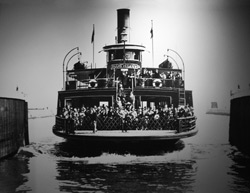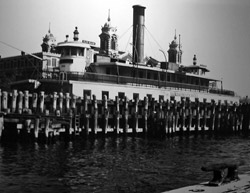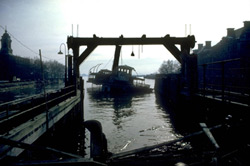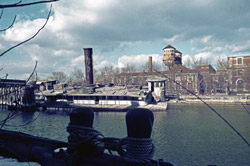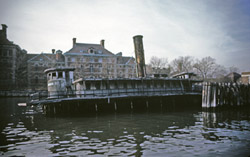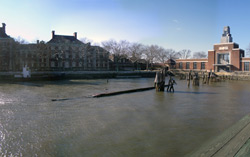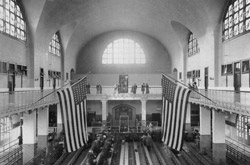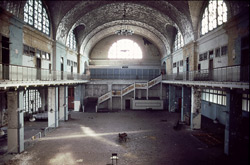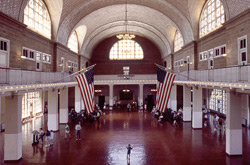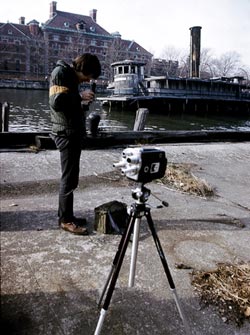
| JUNE 2006 – NO. 7 |

The Sinking of The Ferry Ellis Island
It seemed ironic to me that 37 years after they let her sink at her slip, the National Park Service was taking credit in Smithsonian and Archaeology Today for surveying the sunken wreck.
The ferry Ellis Island was built in 1904, and decommissioned in 1954. The island itself was transferred to the control of the National Parks Service in 1962, and the ferry sank at its slip there six years later. Forty percent of Americans trace their roots to an ancestor that came through Ellis Island, most having left the island via the ferry Ellis Island. The ferry took them to the Central Railroad of New Jersey terminal in Jersey City, where they transferred to trains that would take them to inland states in the interior of the country. In fact, the ferry terminal on Ellis Island is actually part of New Jersey rather than New York — in 1993 the U.S. Supreme Court ruled that the south side of the island belonged to New Jersey because all the landfill was in New Jersey waters.
Ferry Ellis Island, 1974
I first saw the ferry Ellis Island in 1974, when I was 17. She was sunk at her slip, with her deck still above water. I wondered then why she was abandoned. A friend, Steve Siegel, and I had rowed out to the island to make a documentary film. We were part of the Young Filmmakers Foundation's Film Club, and we thought the island would be a great topic for a film. It also promised to be a great adventure. (Incidentally, the film, Ellis Island, was shown at the 2005 Tribeca Film Festival as part of retrospective honoring Roger Larson, founder of Young Filmmakers, titled "Young Filmmakers Rediscovered: 1964-1974.")
We made four or five trips to the island in a 12-foot aluminum rowboat, launching from the shore of a large unused railroad yard that is now part of Liberty State park. It was quiet an amazing experience to explore the island, years before the Liberty-Ellis Island Foundation was established to restore the island. I returned to Ellis Island almost exactly 25 years later at the invitation of the National Parks Service. Someone had found my website — modern-ruins.com — and wanted to acquire a copy of the film for the museum. This time, instead of rowing out, I drove out from New Jersey over the construction bridge built during renovations of the north side of the island. While it was good to see the island restored, I couldn't help but feel that something was lost when it was cleaned up and all of the detritus was removed — the files, paper forms, mattresses, and furniture that the immigrants had used 50 years earlier.
Ferry Ellis Island in 1974 and 2006.
One of the first things that struck me was that the ferry wasn't there. A ranger later told me that the hull could be seen only at low tide and that there were discussions about raising the hull. Then last year I read articles in Smithsonian and Archaeology Today magazines that touted the Park Service's Submerged Resources Center's survey of the wreck in 2002. I bet it cost more to survey the ferry than it would have cost to tow her someplace before she sank. I did read that in 1988, divers had tried to re-float the hull after putting a patch on it, but the patch sprang a leak. No word after that; I guess they gave up.
I can't help but imagine how a trip to Ellis Island would be enhanced if visitors could stand aboard the same ferry on which their ancestors left knowing they'd soon become citizens. But no decision has been made as to the fate of what's left of the hull. Leaving it there is almost a no-decision, costing nothing, and is what I bet will happen. Then she'll slowly rust away. In preservation circles they call it demolition by neglect.
The main hall: in operation at Ellis Island, and in 1974 and 1997.
During my visits, much of the same attitude seemed to have been taken with the buildings on the south side of the island. On my first trip in 1974, I was surprised to see so few broken windows and the tile roofs looking pretty much intact. When I returned 25 years later, I could see trees growing on the roofs, ripping them open and allowing rainwater to cause extensive damage to the buildings. Congress authorized six million dollars in 1965, but it wasn't appropriated supposedly because of the demands of the Vietnam War. In 1976, one million dollars were finally appropriated, with $500,000 per year for operating expenses. But by then, just fixing the seawall that was left to collapse would cost five million dollars, so the island simply continued to decay. Even after the restoration of the main hall, little maintenance was done on the rest of the island and decay continued for the next 25 years, until private funds were raised and the buildings "stabilized" a few years ago. The Save Ellis Island Foundation is now looking to raise 300 million dollars to restore those buildings.
While I was on the island the Park Service wanted to conduct an oral history for the museum on Steve and my exploits in making the film. It was all very serious, recorded in a special room with two different sets of questions — one for immigrants and one for people that worked on the island. They decided to use the immigrant questionnaire for me. The first question was "What is the name of the ship on which you arrived?" I just laughed and said, "Our rowboat didn't have a name." They also asked for a copy of our film as well as copies of photos I'd taken in 1974. It seems that in the restoration they cleaned up too well and erased traces of the group of "squatters" that took over the island in 1970 — I had photos of the clothing and monopoly board game they left behind. They also asked for copies of photos I'd taken of signs that had since faded away into oblivion.
Photographs courtesy Phil Buehler.
